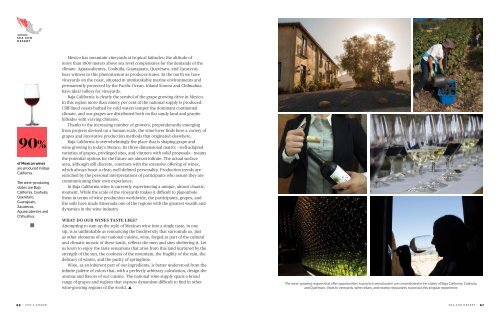ven-a-comer-e-book-en_1
ven-a-comer-e-book-en_1
ven-a-comer-e-book-en_1
You also want an ePaper? Increase the reach of your titles
YUMPU automatically turns print PDFs into web optimized ePapers that Google loves.
sea and<br />
desert<br />
90%<br />
of Mexican wines<br />
are produced in Baja<br />
California.<br />
The wine-producing<br />
states are Baja<br />
California, Coahuila,<br />
Querétaro,<br />
Guanajuato,<br />
Zacatecas,<br />
Aguascali<strong>en</strong>tes and<br />
Chihuahua.<br />
n<br />
Mexico has mountain vineyards at tropical latitudes; the altitude of<br />
more than 1800 meters above sea level comp<strong>en</strong>sates for the demands of the<br />
climate. Aguascali<strong>en</strong>tes, Coahuila, Guanajuato, Querétaro, and Zacatecas<br />
bear witness to this ph<strong>en</strong>om<strong>en</strong>on as producer-states. In the north we have<br />
vineyards on the coast, situated in unmistakable marine <strong>en</strong>vironm<strong>en</strong>ts and<br />
perman<strong>en</strong>tly protected by the Pacific Ocean. Inland Sonora and Chihuahua<br />
have ideal valleys for vineyards.<br />
Baja California is clearly the symbol of the grape growing drive in Mexico.<br />
In this region more than ninety per c<strong>en</strong>t of the national supply is produced.<br />
Cliff-lined coasts bathed by cold waters temper the dominant contin<strong>en</strong>tal<br />
climate, and our grapes are distributed both on flat sandy land and granite<br />
hillsides with varying climates.<br />
Thanks to the increasing number of growers, preponderantly emerging<br />
from projects devised on a human scale, the wine lover finds here a variety of<br />
grapes and innovative production methods that originated elsewhere.<br />
Baja California is overwhelmingly the place that is shaping grape and<br />
wine growing in today’s Mexico. Its three-dim<strong>en</strong>sional matrix —well-adapted<br />
varieties of grapes, privileged sites, and vintners with solid proposals— means<br />
the pot<strong>en</strong>tial options for the future are almost infinite. The actual surface<br />
area, although still discrete, contrasts with the ext<strong>en</strong>sive offering of wines,<br />
which always boast a clear, well-defined personality. Production tr<strong>en</strong>ds are<br />
<strong>en</strong>riched by the personal interpretations of participants who assure they are<br />
communicating their own experi<strong>en</strong>ce.<br />
In Baja California wine is curr<strong>en</strong>tly experi<strong>en</strong>cing a unique, almost chaotic,<br />
mom<strong>en</strong>t. While the scale of the vineyards makes it difficult to pigeonhole<br />
them in terms of wine production worldwide, the participants, grapes, and<br />
the soils have made Ens<strong>en</strong>ada one of the regions with the greatest wealth and<br />
dynamics in the wine industry.<br />
What Do Our Wines Taste Like?<br />
Attempting to sum up the style of Mexican wine into a single taste, in one<br />
sip, is as unthinkable as r<strong>en</strong>ouncing the biodiversity that surrounds us. Just<br />
as other elem<strong>en</strong>ts of our national cuisine, wine, forged as part of the cultural<br />
and climatic mosaic of these lands, reflects the m<strong>en</strong> and sites sheltering it. Let<br />
us learn to <strong>en</strong>joy the taste s<strong>en</strong>sations that arise from this land nurtured by the<br />
str<strong>en</strong>gth of the sun, the coolness of the mountain, the fragility of the rain, the<br />
delicacy of winter, and the purity of springtime.<br />
Wine, as an inher<strong>en</strong>t part of our ingredi<strong>en</strong>ts, is better understood from the<br />
infinite palette of colors that, with a perfectly arbitrary calculation, design the<br />
aromas and flavors of our cuisine. The national wine supply spans a broad<br />
range of grapes and regions that express dynamism difficult to find in other<br />
wine-growing regions of the world. ▲<br />
The wine-growing regions that offer opportunities to practice o<strong>en</strong>otourism are conc<strong>en</strong>trated in the states of Baja California, Coahuila,<br />
and Querétaro. Visits to vineyards, wine cellars, and nearby restaurants round out this singular experi<strong>en</strong>ce.<br />
66 — V<strong>en</strong> a Comer sea and deserT — 67


